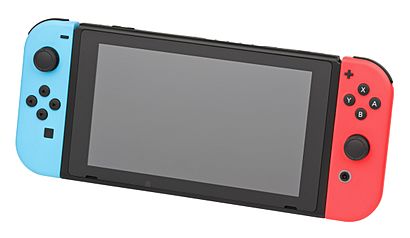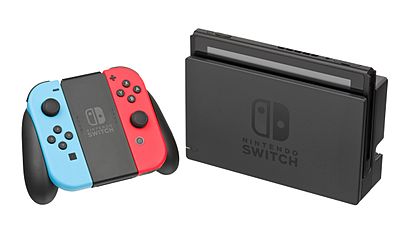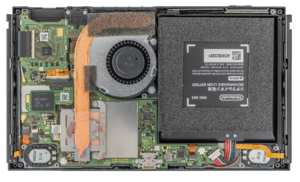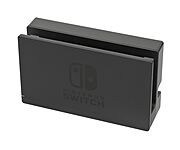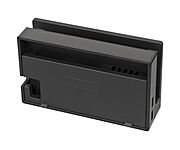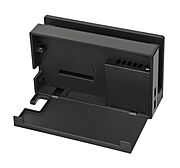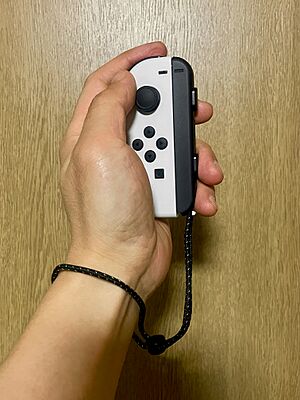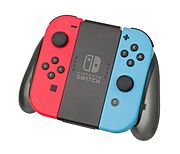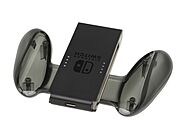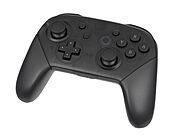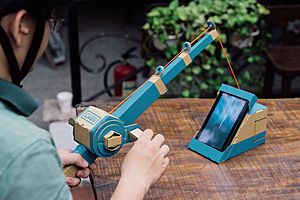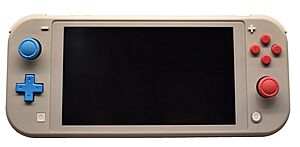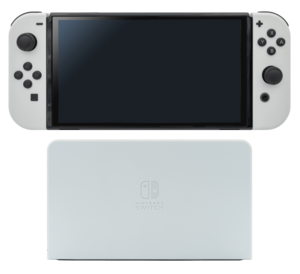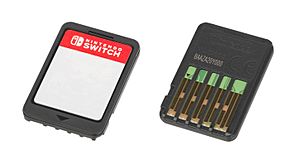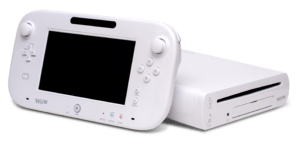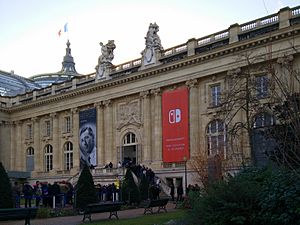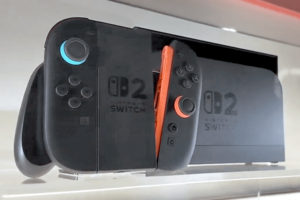Nintendo Switch facts for kids
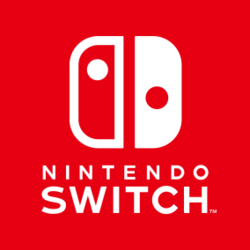 |
|
|
|
| Developer | Nintendo PTD |
|---|---|
| Manufacturer |
|
| Type | Video game console |
| Generation | Eighth / Ninth |
| Release date |
|
| Introductory price | |
| Units shipped | 152.13 million (as of 2025[update], details) |
| Media |
|
| Operating system | Nintendo Switch system software |
| Power |
|
| System-on-chip used | Nvidia Tegra X1 |
| CPU | Quad-core ARM Cortex-A57 @ 1.02 GHz |
| Memory | 4 GB LPDDR4 |
| Storage |
|
| Removable storage | microSD, up to 2 TB |
| Display | |
| Graphics |
|
| Sound |
|
| Input |
|
| Connectivity |
|
| Online services |
|
| Dimensions |
|
| Weight |
|
| Best-selling game | Mario Kart 8 Deluxe (68.20 million, as of March 31, 2025[update]) (list) |
| Predecessor | |
| Successor | Nintendo Switch 2 |
The Nintendo Switch is a video game console made by Nintendo. It was first released around the world on March 3, 2017. The Switch came out during the time of the eighth generation of home consoles. It followed the Wii U and competed with Sony's PlayStation 4 and Microsoft's Xbox One. It also competes with newer consoles like the PlayStation 5 and Xbox Series X/S.
The Switch is a special kind of tablet that can be used in different ways. You can put it in a dock to play games on your TV, or you can take it out and use it as a portable device. This makes it a hybrid console. Its wireless Joy-Con controllers can be used as two halves of a regular controller, or as separate controllers for two players. They have buttons, joysticks, motion sensors, and vibration feedback. You can attach them to the sides of the console for handheld play, or put them on a grip to make a traditional gamepad.
The Switch's software lets you play games online using the internet. You can also connect with other Switch consoles nearby using wireless ad hoc for local multiplayer. Switch games come on small flash-based game cards or as digital downloads from the Nintendo eShop. The system does not have region lockout, meaning you can play games from any country. Two updated versions of the console have been released: the smaller, handheld-only Switch Lite (released September 20, 2019) and a version with a better OLED screen (released October 8, 2021).
The Nintendo Switch was first shown on October 20, 2016. Nintendo created it because their previous console, the Wii U, didn't sell well. They also wanted to compete with mobile games. Nintendo's president at the time, Satoru Iwata, encouraged the company to try new hardware and mobile gaming. The Switch was designed for many types of players. Nintendo worked with many other game companies and independent studios to make sure there were lots of games for the Switch. They used common electronic parts, like Nvidia's Tegra chip, to make it easier for developers to create games.
People generally liked the Switch. They praised its smart design and the many games available. Some criticisms were about hardware and controller issues. The Switch has been very successful, selling over 150 million units worldwide. It is the third-best selling console of all time, after the PlayStation 2 and Nintendo DS. It is also Nintendo's most successful home console, selling more than the Wii.
A new console, the Nintendo Switch 2, was released on June 5, 2025. It can play most Switch games.
Contents
How the Nintendo Switch Was Made
Early Ideas and Challenges
Nintendo had a lot of success with the Nintendo DS and Wii consoles. But after 2009, their sales started to drop. In 2012, before the Wii U came out, Nintendo lost money for the first time as a video game company. This continued for a few years because the Wii U didn't sell well. Many people thought Nintendo should get into mobile gaming, but the company was careful about it at first.
About three years before the Switch was announced, Nintendo leaders like Satoru Iwata, Tatsumi Kimishima, Genyo Takeda, and Shigeru Miyamoto made a plan. They wanted to make Nintendo's business stronger. This plan included making mobile games and new hardware. Iwata made a deal with a Japanese mobile company called DeNA. This deal led to mobile games based on Nintendo's popular series. After Iwata passed away in July 2015, Kimishima became the new president of Nintendo.
Creating the Switch
Ideas for the Switch started soon after the Wii U was released in 2012. Kimishima said Nintendo didn't just want a new version of the Nintendo 3DS or Wii U. They wanted to create a "new kind of experience." The Switch was designed to offer a "new way to play" that would be more impactful than the Wii U. Nintendo of America president Reggie Fils-Aimé said the console would let players choose to play at home or on the go. This helped developers create new types of games.
Nintendo wanted the Switch to be unique, not just like other consoles. They aimed to create a device that was different and hard for others to copy. Miyamoto said some ideas for the Switch came from Nintendo's long-standing design philosophy of using "lateral thinking with seasoned technology."
The Wii U's struggles also pushed Nintendo to develop the Switch. Major game companies stopped making games for the Wii U because it wasn't selling well. Fils-Aimé said that when it became clear the Wii U wasn't meeting expectations, the Switch became a "make or break product" for Nintendo.
The Switch was designed to connect different types of gamers. It could be used for both "casual" and "deep" video games. It also aimed to fit how people play games in different cultures. For example, Japanese players often play on the go with friends, while Western players might play at home alone. The Switch's design, with its ability to play on a TV or as a portable device, and its detachable controllers, aimed to please everyone. The name "Switch" refers to how it can change between handheld and home console modes. It also means it can "flip and change the way people experience entertainment."
Nintendo got ideas for the Switch's design from feedback about the Wii Remote. Players wanted a smaller Wii Remote that could be attached to their body. This made Nintendo think about a small, portable console with new controllers. Another idea came from Wii U feedback. Players liked the Wii U GamePad, but it stopped working if they moved too far from the console. This led Nintendo to design a home console that players could take anywhere. Nintendo made about five different test versions of the Switch before choosing the final design.
Nintendo also had to balance the console's power with its battery life and size. They also had limited time and money. Instead of making their own chip, they decided to use an existing one. This made it easier for other game developers to create games for the Switch. Nintendo didn't focus on making the most powerful console. Instead, they balanced all the features, including battery life and size, to achieve their vision for the Switch.
Yoshiaki Koizumi was the main producer for the Switch. Miyamoto said that younger employees at Nintendo led the Switch's development. He looked for designers who weren't just huge game fans but had many different interests. This helped them think of new ideas for the Switch's long life.
Announcing the Switch
The first public news about the Switch, then called "NX," came out on March 17, 2015. Nintendo said it was a "brand new concept." In April 2016, Nintendo announced the NX would be released in March 2017. Nintendo didn't show the NX at E3 2016 because they were worried competitors might copy their ideas. Rumors started spreading that it would use Nvidia Tegra hardware, be a "hybrid" device, have detachable controllers, and use game cartridges.
On October 20, 2016, Nintendo officially announced the console as the Nintendo Switch. They released a video showing how it could be used as a hybrid device. Nintendo didn't share many details at first but planned more events later. Miyamoto and Fils-Aimé showed the Switch on The Tonight Show Starring Jimmy Fallon in December 2016. Jimmy Fallon even played a part of The Legend of Zelda: Breath of the Wild live.
Nintendo shared more technical details, including the release date and price, at an event in Tokyo on January 13, 2017. The event was streamed live. A Nintendo Treehouse event the next day showed all the games that would be available at launch and soon after.
Launching the Console
The Switch was released on March 3, 2017, in Japan, most English-speaking countries, and the United Arab Emirates. It cost about $300 in the United States. The package included the Switch console, a dock, left and right Joy-Con controllers with straps, a Joy-Con grip, a power adapter, and an HDMI cable. There were two bundles: one with gray Joy-Con and one with neon red and blue Joy-Con. Nintendo kept the price lower by not including extra hardware or games.
Global Release
The Switch continued to be released in other countries over the next few years. It came out in Argentina on August 15, 2017, and in South Korea and Taiwan on December 1. It was released in Turkey in July 2018. Nintendo's distributor in Singapore launched the Switch in the Philippines on November 30, 2018, in Thailand on March 29, 2019, and in Malaysia on January 17, 2020. It also launched in Israel on March 1, 2019, and in Oman on September 27, 2019.
Before December 2019, the Nintendo Switch was widely available in China through imports from other regions. In April 2019, Nintendo partnered with Tencent to get approval to release the Switch in China. It was released there on December 10, 2019. Tencent helps Nintendo bring more Switch games to China and helps with the Nintendo Switch Online service there.
Nintendo had left the Brazilian market in 2015 due to high taxes. However, independent sellers still sold the console there. In August 2020, Nintendo started importing consoles directly to Brazil again, releasing them on September 18, 2020.
After Launch and Special Editions
Many special-edition Switch models and bundles have been released. These include versions for Splatoon 2, Black Friday 2018, Animal Crossing: New Horizons, and Fortnite. In May 2018, a "2nd Unit Set" was released in Japan for households that already owned a Switch. It cost less because it didn't include the dock or other accessories.
In February 2021, Nintendo president Shuntaro Furukawa said the Switch was "in the middle of its life cycle." By July 2024, the Switch became Nintendo's longest-running console without a replacement.
The Switch Lite came out on September 20, 2019, in yellow, gray, and turquoise. A special Pokémon Sword and Pokémon Shield version was released on November 8, 2019. New colors like coral and blue were released later. A special Pokémon Dialga and Palkia limited edition came out on November 5, 2021. On September 26, 2024, a gold-colored The Legend of Zelda Switch Lite was released with a 12-month Nintendo Switch Online + Expansion Pack membership.
Nintendo Switch Hardware
The Nintendo Switch is a hybrid video game console. It has a main console unit, a dock, and two Joy-Con controllers. Nintendo calls it "a home console that you can take with you on the go." While Nintendo didn't say it was a direct replacement for the Wii U or 3DS, it has taken over their roles as Nintendo's main home and handheld console. The Wii U was stopped shortly before the Switch's launch, and the 3DS stopped production in 2020.
The Console Unit
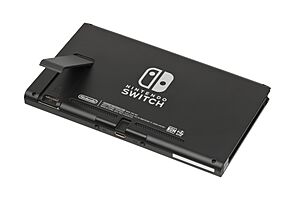
The main part of the Nintendo Switch is its console. It's a tablet that runs on a battery. It has a 6.2-inch LCD touchscreen. This screen is the same size as the Wii U GamePad. The console is about 6.8 inches wide, 4 inches high, and 0.5 inches deep. It weighs about 0.65 pounds. The screen shows 720p resolution (1280×720 pixels) and can sense ten touches at once. It also has haptic technology for vibrations.
The console has a 3.5 mm audio jack, stereo speakers, a USB-C charging port, and a kickstand on the back. It also has a game card slot on top and a microSD card slot under the kickstand. Volume controls and a power button are on top. Rails on the sides let the Joy-Con controllers slide on and attach. A sensor adjusts the screen brightness automatically.
The Switch has three ways to play:
- TV mode: The console sits in its dock and connects to a television.
- Tabletop mode: You use the kickstand to play on a flat surface, sharing the screen.
- Handheld mode: You hold the console like a traditional portable gaming device.
Switching between these modes is easy. You just dock or undock the console, adjust the kickstand, or attach/detach the Joy-Con controllers. Some games are made for specific modes. For example, Super Mario Party does not support Handheld mode.
The Switch shows content on one screen at a time. It's either on the console itself or on a TV. It doesn't use two screens at once like the Wii U. Nintendo has a way to link multiple Switch consoles together to create a bigger screen setup. This was first used in Super Mario Party.
The Dock
The Nintendo Switch console can be placed into the Switch dock. This docking station charges the console's battery. It also sends video and audio to a television using an HDMI cable. The dock has two USB 2.0 ports and one USB 3.0 port. When docked, the console can show games in up to 1080p resolution at 60 frames per second. The actual resolution depends on the game.
The dock is about 6.8 inches wide, 4.1 inches high, and 2.1 inches deep. It weighs about 0.72 pounds. The dock that comes with the OLED model has a slightly different design. It also has a built-in Ethernet port for a wired internet connection.
- Nintendo Switch dock
-
Back of the dock, showing its two USB ports on the right side
Controllers
Joy-Con Controllers
The Nintendo Switch comes with two controllers called Joy-Con. They are known as "Joy-Con (L)" (left) and "Joy-Con (R)" (right). These controllers attach to the sides of the console with a special lock. A small button on the back lets you detach them. When connected to the console, the Joy-Con charge automatically.
When detached, you can use them in a few ways:
- As a pair for one player.
- Attached to a grip accessory to feel like a regular gamepad. This grip can also charge them using USB-C.
- Separately as individual controllers for two players.
You can attach straps to the Joy-Con for a better grip when they are detached. A charging grip that uses AA batteries is also available. One Switch console can connect to up to eight Joy-Con at the same time.
Pro Controller
The Nintendo Switch Pro Controller is a separate wireless controller. It looks more like a traditional controller, similar to the Wii Classic Controller Pro. It connects to the Switch using Bluetooth and charges with a USB-C port.
- Standard Switch controllers
Other Accessories
The Nintendo Switch supports many other accessories. Nintendo's leaders have said the Switch is part of a larger system of devices. They also hinted that other types of controllers could attach to the console to change how it's used.
Nintendo offers a Joy-Con Wheel, which is a small steering wheel that a Joy-Con can fit into. This is great for racing games like Mario Kart 8 Deluxe. You can also buy separate docks, which come with a power adapter and HDMI cable. Other companies make accessories like carrying cases and screen protectors.
After a system update, the Switch can use GameCube controllers with an adapter. These controllers work with most games that support the Switch Pro Controller, like Super Smash Bros. Ultimate. You can also use USB computer keyboards for typing.
In January 2018, Nintendo announced Nintendo Labo. This is a platform for kids that combines games with do-it-yourself cardboard projects. These cardboard creations, called Toy-Con, attach to the Switch console and Joy-Con. The game software gives instructions for building the Toy-Con and lets you control them. For example, you can build a remote-controlled "car" where the Joy-Con's vibrations make it move. Or a fishing rod where the Joy-Con are part of the reel and handle.
In September 2018, with the release of Nintendo Switch Online, Nintendo introduced NES Controller-style Joy-Con. These were for playing classic NES games. Later, SNES games were added, and wireless SNES Controllers were released. In September 2021, Nintendo 64 and Sega Genesis games were added as part of the Expansion Pack subscription. Wireless Nintendo 64 Controllers and Sega Genesis Control Pads were released for these services.
Nintendo released Ring Fit Adventure in October 2019. This game comes with a Leg Strap for a Joy-Con and a flexible plastic ring called the Ring-Con. Players interact with the game by doing exercises like running, squatting, and squeezing the ring. This helps them perform actions in the game. This is part of Nintendo's goal to combine physical activity with the Switch, similar to games like Wii Fit.
Nintendo also released a Labo VR kit in March 2019. It uses a cardboard headset and viewer that you place the console's screen into. This lets you experience virtual reality with attached accessories.
Technical Details
Inside the Console
The Switch uses a special system-on-chip (SoC) from the Tegra family, made with Nvidia. This chip is designed to give good performance while using little power. It helps make games look similar to those on personal computers. Reports say the SoC is an Nvidia Tegra X1. It has four ARM Cortex-A57 CPU cores and 256 Maxwell-based CUDA GPU cores.
The CPU cores usually run at 1020 MHz. A software update in April 2019 allowed the CPU to speed up to 1785 MHz during game loading. This helps games load faster. The GPU cores run at 768 MHz when the Switch is in the dock. In Handheld mode, the GPU speed changes between 307.2 MHz, 384 MHz, and 460 MHz. The Switch has 4 GB of LPDDR4 memory. It runs at 1600 MHz in TV mode and 1331.2 MHz in Handheld mode.
Wireless Connections
The Switch has Wi-Fi 5 for internet connection. Up to eight Switch consoles can connect wirelessly for local multiplayer games. The Switch uses Bluetooth 4.1 to connect wirelessly with its controllers. You can also buy a USB LAN adapter for a wired internet connection when the console is docked.
Power and Battery
In Handheld mode, the Switch runs on a built-in 4,310 mAh Lithium-ion battery. The battery lasts between 2.5 and 6.5 hours, depending on the game. For example, The Legend of Zelda: Breath of the Wild uses about three hours of battery life. The battery charges when in the dock or through a standard USB-C port on the console. It takes about 3 hours to recharge in sleep mode. Each Joy-Con has its own battery that lasts about twenty hours. These batteries charge automatically when attached to the console.
Storage
The Switch has 32 GB of internal storage, with about 25.9 GB available for games. You can expand this storage up to 2 TB using a microSD, microSDHC, or microSDXC card. The microSD card slot is under the Switch's kickstand. Game save data is always stored on the console's internal memory.
At launch, you couldn't transfer save files to another Switch. But a system update in October 2017 added this feature. An April 2020 update allowed you to move game updates, digital games, and other downloaded content between the internal memory and a microSD card.
Other Connections
The Switch console has a 3.5 mm headphone jack. At first, it didn't support Bluetooth wireless headphones directly. But a system update in September 2021 added full support for Bluetooth headphones without needing an adapter.
Newer Versions
Around July 2018, Nintendo quietly released Switch units with small hardware changes. These changes blocked ways to use exploits in the original models. In July 2019, Nintendo announced an updated version of the Switch (model "HAC-001(-01)"). This version uses a more efficient chip, the Tegra X1+. This extended the battery life to 4.5–9 hours.
How the Switch is Made
The Nintendo Switch is made by Foxconn in Taiwan and Hosiden in Japan. Foxconn makes most of them. Nintendo did not want to sell the Switch for less than it cost to make, unlike some of their past consoles. They wanted the Switch to be profitable from the start. Experts estimated that the Switch cost about $257 to make, compared to its $299 retail price.
Before the launch, Nintendo planned to ship two million Switch units in the first month. They wanted to make sure there were enough consoles to meet demand. Nintendo hoped the Switch would sell as many units as the Wii, which sold 101 million.
After the first sales reports in April 2017, Nintendo aimed to produce 18 million Switch units in its 2017 financial year. This was to avoid shortages, especially around the 2017 holiday season and the release of Super Mario Odyssey. In October 2017, reports said Nintendo increased production to 2 million units per month.
In June 2019, Nintendo started moving some Switch production out of China to avoid new taxes. In November 2020, Nintendo asked its partners to increase Switch production by 20%. This was due to high demand, especially because of the success of Animal Crossing: New Horizons during the COVID-19 pandemic.
Other Models of the Switch
Nintendo Switch Lite
The Nintendo Switch Lite is a version of the Switch made only for handheld play. It was released on September 20, 2019, and cost about $199.99. The Switch Lite is a single unit, meaning the Joy-Con are built into the console and cannot be removed. It has a smaller 5.5-inch screen. It also has a regular directional pad instead of four separate directional buttons on the left side.
Even though it has a smaller battery, the Switch Lite uses a more power-efficient chip. This extends its battery life to 3–7 hours on a single charge. Nintendo wanted to make a Switch model that cost less than $200. This was to compete with gaming services that don't need a special device.
The Switch Lite usually only plays games that work in handheld mode. It still has features like motion sensors, Bluetooth, Wi-Fi, and NFC. Some games that need HD Rumble or IR camera features, like 1-2-Switch, require you to use separate Joy-Con controllers with the Switch Lite. The system cannot connect to a television, so it won't work with games that need TV mode. If you try to buy a game that needs TV or tabletop mode on the eShop with a Switch Lite, you will be warned. The Switch Lite does support external controllers like regular Joy-Con, but they can't be attached to the system.
OLED Model
On July 6, 2021, Nintendo announced a new model called the Nintendo Switch – OLED Model. This model has a larger 7-inch 720p OLED screen. When docked, it still outputs to 1080p resolution, like the original model. It also has 64 GB of internal storage, better sound, a magnesium alloy body, and a wider adjustable stand for tabletop mode. The new dock that comes with it includes a wired LAN port.
The OLED model has similar technical parts as the original Switch. It can play all Switch games and use existing accessories. It comes in two bundles: one with a black dock and red and blue Joy-Con, and one with a white dock and white Joy-Con. It was released on October 8, 2021, along with Metroid Dread, and cost about $349.99.
Before the OLED version came out, Nintendo lowered the price of the original Switch model in Europe and the UK. However, other regions like North America and Australia did not get a price cut. Four special-edition OLED models have been released: for Splatoon 3, Pokémon Scarlet and Violet, The Legend of Zelda: Tears of the Kingdom, and a "Mario Red Edition" for Super Mario Bros. Wonder.
Nintendo Switch Software
The Nintendo Switch uses its own special operating system called Horizon. The Switch's user interface shows games as tiles. These games can be from a game card or stored on the console. It has quick buttons for Nintendo news, the Nintendo eShop, and a photo album for screenshots. A software update in October 2017 also allowed capturing and sharing video from some games.
One Switch console can have up to eight user profiles. Each profile can be linked to a Nintendo Account. You can choose an avatar from a gallery or use a Mii for your profile. The Switch's Mii editor has more color options than previous Nintendo consoles. In February 2022, Nintendo added a "Missions and Rewards" system for Nintendo Switch Online subscribers. This lets them earn points to get special icon parts from different Nintendo games.
Security Measures
Nintendo has a program to find security weaknesses. They work with a website called HackerOne. Nintendo offers up to $20,000 to people who find vulnerabilities that could lead to piracy, cheating, or sending inappropriate content. The reward depends on how serious the flaw is.
In April 2018, two groups found a way to use a weakness in the Tegra chip to run other software on the Switch. This weakness could not be fixed with a software update. Nintendo can ban Switch consoles that use this exploit from the Nintendo Network. This is because each Switch has a unique ID used to connect to the network. Nintendo has fixed this weakness in newer Switch units since July 2018.
In June 2018, hackers found a way to access the Switch's developer menu on regular consoles. This allowed users to load games directly onto SD cards or create custom avatars. Nintendo has banned modified Switch systems.
After Nintendo Switch Online launched in September 2018, hackers found a way to run unauthorized game files on the NES emulator.
Online Services
Nintendo Switch user profiles can be linked to a Nintendo Account. This lets you use online features and buy games from the Nintendo eShop. You can create a Nintendo Account using a social media account or an existing Nintendo Network ID from a 3DS or Wii U. Nintendo doesn't plan to have its own social media services like Miiverse on the Switch. Instead, you can link your profile to existing social networks like Facebook.
You can add friends using Friend Codes, by searching for friends on your local network, or through past multiplayer games. You can also add friends from Nintendo mobile apps like Mario Kart Tour. Support for adding friends via Facebook was added in March 2018. If you link your Nintendo Network ID to your Nintendo Account, you can add friends from your 3DS or Wii U. You can also share eShop money across all three systems.
Like with PlayStation and Xbox consoles, you need a subscription to play most games online. The Nintendo Switch Online subscription includes:
- Access to online play.
- Voice chat (through a mobile app).
- Access to a library of classic Nintendo Entertainment System (NES), Super Nintendo Entertainment System (SNES), and Game Boy games.
- cloud storage for game save data.
- Special offers and promotions.
A premium "Expansion Pack" subscription was launched in October 2021. This added Nintendo 64 and Sega Genesis games to the classic library. Game Boy Advance (GBA) games were added in February 2023. The Expansion Pack also includes access to some paid downloadable content (DLC), like the Mario Kart 8 Booster Course Pack. Free-to-play games like Fortnite Battle Royale do not require a subscription for online play.
The Nintendo Switch Online mobile app lets subscribers use voice chat. Unlike other consoles, voice chat is not directly supported on the Switch console itself. A separate app provides parental controls for the console.
Media and Apps
The Switch did not launch with many multimedia features like a web browser or video streaming services. Nintendo focused on making it a great gaming console first.
Niconico, a Japanese video service, was the first third-party media app for the Switch in Japan in July 2017. Hulu was the first video streaming app in the United States in November 2017. A YouTube app was released in November 2018. A Tencent Video streaming app was launched in China in November 2020. Funimation launched its streaming app in December 2020. A Twitch app was released in November 2021 but was stopped in January 2024.
Music production app Korg Gadget was released in April 2018. InkyPen, a comics and manga subscription app, launched in December 2018. Izneo, another comics and manga service, was released in February 2019. FUZE4, a programming language app, was released in August 2019.
Nintendo Switch Games
How Games are Distributed
You can get games for the Nintendo Switch from stores or digitally from the Nintendo eShop. Games sold in stores come on small cartridges. These are similar to Nintendo 3DS game cards but smaller. The Switch is the first major home console since the Nintendo 64 to use cartridges. Because the cartridges are so small, Nintendo coats them with a non-toxic bitterant to stop children from putting them in their mouths.
Nintendo suggested a price of $60 for Switch games when it launched, similar to Xbox One and PlayStation 4 games. Nintendo lets publishers set game prices, but usually requires the physical and digital versions to cost the same. This can sometimes make Switch games more expensive than on other consoles, due to the cost of making the game cards. This price difference is sometimes called the "Switch tax."
Game cards had a 32 GB capacity when the Switch first came out. Nintendo planned to introduce 64 GB cards later. Some physical games might still need to install content to the console's internal storage, especially if you don't have a microSD card. Some games, like NBA 2K18, even require a microSD card to be present. These games are clearly marked on their covers.
The Switch also supports cloud gaming. This lets you play games that need more powerful hardware by running them on servers over the internet. These games might be limited to certain regions. Examples include Control and Hitman 3.
Unlike previous Nintendo home consoles, the Switch is region-free. This means you can use game cartridges or downloaded content from any part of the world. However, Chinese game content can only be played on Switch units made for China. Nintendo recommends using the correct regional eShop for digital purchases to get the best support. Nintendo made the Switch region-free to make it easier and cheaper for themselves and developers.
The Switch does not use discs, so it cannot play games from older Nintendo consoles directly. It also isn't compatible with digital games from previous consoles. However, you can play emulated versions of games from older Nintendo systems through the eShop and the Nintendo Switch Online service. These are now called Nintendo Classics.
Support from Other Companies
One reason the Wii U didn't do well was a lack of support from other game developers. Nintendo worked hard to get many other companies to support the Switch early on. They talked directly with many third-party developers. Companies like Electronic Arts said Nintendo listened to their ideas to make the Switch more successful.
Nintendo also started working with independent game developers in 2016. They helped these indie developers bring their games to the Switch. Nintendo sees games like Snipperclips as a good example of the indie games they want. They helped these developers with Switch support and software tools early on. Many indie developers have said that Nintendo has been very helpful in promoting their games.
When the Switch was first shown in October 2016, Nintendo didn't give a list of games. Instead, they announced that 48 other game companies and studios had promised to support the Switch. This was a big change from Nintendo's past struggles to get third-party support. Major publishers like Activision, Bethesda, Electronic Arts, Sega, Square Enix, Take-Two Interactive, and Ubisoft were on the list.
Nintendo used to provide its own tools for developers to make games. But with the Switch, they changed their approach. They wanted to make it easy for many different developers to create games. The Nvidia chip supports many standard tools, which makes it easier to bring games from other platforms to the Switch. Companies like Unity Technologies and Epic Games helped developers use their game engines, Unity and Unreal Engine 4, for Switch games. In March 2018, Nintendo also added support for YoYo Games' GameMaker Studio 2 engine. Many indie developers have said the Switch was "the least demanding Nintendo console" to develop for.
By 2022, the Switch was seen as having successfully brought back support from other game companies. This was due to Nintendo's efforts to work with them.
Game Library
The Legend of Zelda: Breath of the Wild, which was first announced for the Wii U, was released for the Switch on its launch day. The console's first video showed parts of new games like Super Mario Odyssey, Mario Kart 8 Deluxe, and Splatoon 2. It also showed NBA 2K18 and The Elder Scrolls V: Skyrim. All these games were later confirmed for the Switch.
The Switch launched with games like 1-2-Switch, Fast RMX, Just Dance 2017, The Legend of Zelda: Breath of the Wild, Snipperclips, and Super Bomberman R. The Switch did not come with any games bundled or pre-loaded. Nintendo wanted consumers to choose which games to buy.
Nintendo planned to release new games regularly after launch, avoiding long gaps between major releases. This helps keep people playing the system and keeps sales strong. Journalists noticed that Nintendo followed this plan, releasing a new first-party game almost every month into early 2018. 2023 was a record year for the Nintendo Switch, with 2,360 games released.
Virtual Game Cards
In a Nintendo Direct event at the end of March 2025, Nintendo announced that Switch consoles, including the original and its successor, would support Virtual Game Cards. This feature lets users own a physical key to activate digitally encrypted software and transfer games between consoles. Virtual Game Cards can also be loaned to other users within a Nintendo Switch Online Family account for two weeks, then they automatically return to the owner. This feature was activated with a system update on April 29, 2025.
Marketing the Nintendo Switch
A key part of marketing the Switch was to be "crystal clear" about what the product was and what it could do. This was to avoid problems like with the Wii U. Many people thought the Wii U GamePad was just a tablet or an accessory for the old Wii, not part of a new console. For the Switch, Nintendo wanted to clearly show that it was "a home console you can take on the go."
For example, the October 2016 video was designed to show all the ways the Switch could be used. It showed that "each of its forms offer different play experiences." Kimishima said the video aimed to show that the device was for all types of players. A lot of Nintendo's early marketing focused on the game Breath of the Wild. This was to attract both older players who grew up with Zelda and new players.
Nintendo aired its first-ever Super Bowl ad during the United States broadcast of Super Bowl LI. The ad showed the Switch's different play modes and games. This showed Nintendo's confidence in the system.
More TV commercials followed, showing the Switch being used by different groups of people. These ads appeared during events like the 2017 NCAA Division I men's basketball tournament and on channels like Nickelodeon. Nintendo said their marketing for the Switch would be a long campaign, not just for a few weeks.
Nintendo also planned many "sampling events" where people could try the system before it was released. Kimishima felt it was important for players to experience the Switch firsthand. Nintendo also did "guerrilla marketing," setting up temporary living-room-style spaces in different places for fans to try the console.
In June 2018, Nintendo partnered with Disney Channel to create Nintendo Switch Family Showdown. This was a TV show where families competed in challenges using Switch games.
The Nintendo Switch 2
The new console, the Nintendo Switch 2, was officially shown on January 16, 2025. It was released on June 5, 2025. More details were shared in an April 2 Nintendo Direct. Hands-on events were held around the world in April.
Rumors about a new console started in July 2023. Nintendo's game development partners reported receiving development kits for the new system. Nintendo hinted at a successor console, saying they would keep Nintendo Accounts.
Sources like Eurogamer said Nintendo showed off features of the new console to developers at Gamescom 2023 behind closed doors. Documents from a court case showed that Activision was told about the "Switch NG" (Next Generation) in late 2022. Its performance was said to be similar to the PlayStation 4 and Xbox One.
Confirmed changes for the Switch 2 include a larger screen, a redesigned kickstand, and Joy-Con that connect with a plug-like slot instead of a sliding rail. The new console's chip, the Nvidia Tegra T239, has an octa-core ARM Cortex-A78C CPU and a 12 SM Ampere GPU. It also has 12 GB of LPDDR5X-7500 RAM and 128 GB of UFS 3.1 internal storage. Sharp Corporation said it had been providing 8-inch LCD screens for the new console since mid-2023. Other reports said the new console would have DLSS and ray tracing. Developers were shown tech demos like The Legend of Zelda: Breath of the Wild running at 4K resolution and 60 frames per second.
The Switch 2 can play most physical and digital Switch games. It will also continue to use the Nintendo Switch Online service. Some Switch games, like Breath of the Wild, might get "enhanced" versions to use the new hardware. The new console also has magnetic Joy-Con and a different dock design. A new Mario Kart game was shown in the reveal video.
Nintendo president Furukawa said in February 2025 that Nintendo plans to keep supporting the original Switch console as long as people want it, even after the Switch 2 is released.
See also
 In Spanish: Nintendo Switch para niños
In Spanish: Nintendo Switch para niños
- Nintendo Switch emulation
- Steam Deck, a similar device released in 2022.


